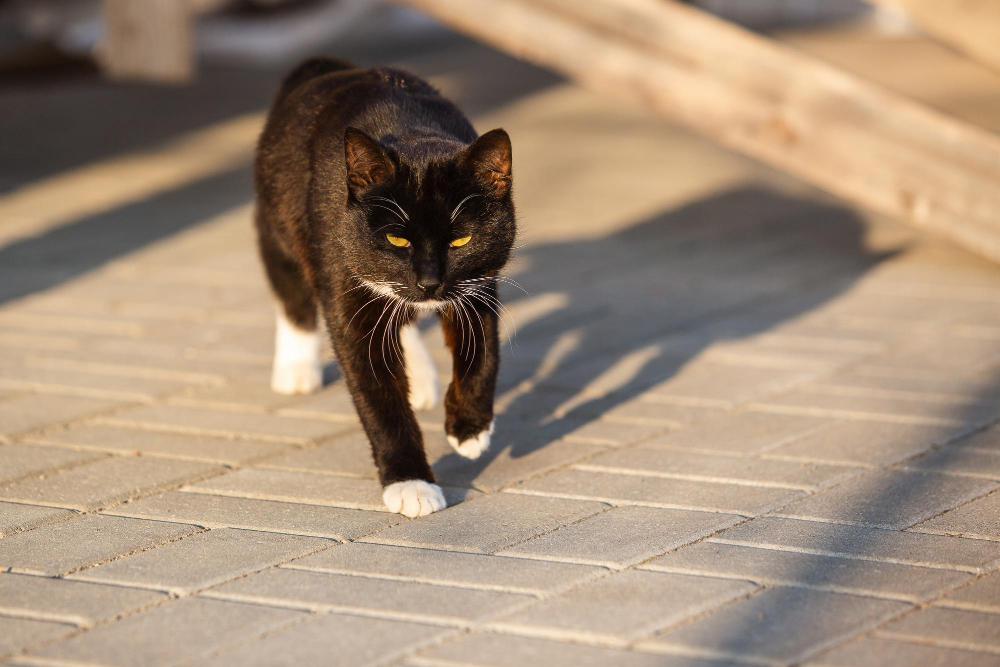It’s not uncommon for some indoor cats to have a strong urge to go outside and explore the world around them. However, trying to contain an intrepid kitty who makes a mad run for the door it opens can be a hassle.
Nonetheless, many cats like spending time outside, but there are several circumstances wherein your cat may be accidentally let out of the house. While inside, you should train your cat to be careful about moving vehicles, just in case it accidentally wanders out.
Positive reinforcement will help your cat learn what they need, but they’ll do it as you instruct them. Beating your cat will exacerbate the problem by making your cat frightened of you in the future.
If you consent your indoor cat to roam freely outside, they are at risk of being hit by a vehicle. However, some steps can be taken to reduce the risk of illness or injury.
All cats, particularly males, should be neutered. Male cats without being neutered have more significant territories than neutered cats so they will monitor these areas consistently.
A bright, reflective collar for the cat is another option. Using this accessory is analogous to wearing a high-visibility jacket to help drivers notice your cat when it’s dark outside. In addition, your cat is less likely to be hit by a vehicle if you bring it inside for the night.
You can keep your cat out of harm’s way without sacrificing its safety from being hit by a car. By building a safe enclosed patio for the cat, this can be achieved.
This is a good position for you and the cat because it allows the cat to benefit from being outside while keeping it secure. Also, you can put a harness and collar on your cat and go on a stroll with it.
Can You Teach a Cat to Stay Away from the Road?
The answer is contingent on your location, the life experiences of your cat, and the cat’s genetic make-up. Because of this, cats not used to being around cars are more likely to get hit by one.
When you park your automobile, you’re protected from the elements, outsiders, and even other animals. However, there is a substantial variation between a cat and a fast-moving car.
Your car may also be viewed differently by a cat. For example, it retains your fragrance, and the cat may have observed your interactions with it.
Cats typically avoid loud noises or scents that bother them. This could be a reason for a cat to avoid being in a moving vehicle.
As anyone who has tried it knows, this is not a guarantee. Cats have been hit by cars in several instances where the cat appeared to run in front of the vehicle out of nowhere.
Having grown up along a major thoroughfare, a cat may have been acclimated to the sounds of passing vehicles. The sound of an approaching vehicle’s engine may not arouse anxiety or suspicion. However, this cat may be less cautious when crossing the road or sitting in driveways.
Cats aren’t the only animals that can be injured by a moving vehicle. Cats tend to curl up in compact, enclosed quarters when it’s chilly outside, especially on days with frost or snow.
As so many cat owners have learned the hard way, this could be found under the vehicle. On top of the wheels or in the engine, Whenever the car is started, your cat is at risk of suffering various painful and even lethal injuries.
Cats cannot cool themselves down by sweating their entire bodies. Unfortunately, many of these car-cat collisions result from unwitting owners knocking over their pets.
How Do You Teach a Cat Where Not to Go?
- Give him the freedom to move about. Keep his leash in your hand and let him sniff about the yard at will. Make sure you have a firm grip on the leash if he becomes scared by something. The leash could fall out of your grasp if this happens.
- In addition to being uncomfortable for your cat, tugging the cat by the leash increases the likelihood that he will break free from his harness. There is nothing that a cat can’t do when it comes to escape. Using the leash, you can make it much simpler for him to squirm out of his harness, and once he gets the hang of it, he will do it again and again.
- Incentivize your cat to come to you or the home by giving him a treat. In addition, it would help if you praised your cat whenever he approached you or the house. A rod with a string and a toy mouse is an excellent outdoor use.
- Work your way up to allow the cat to roam more freely. It’s time to take him outdoors and let his leash dangle on the ground. Reward him for sticking close to the house and letting him explore a little bit on his own. If your cat keeps within the bounds, he’ll be allowed to roam around, but playtime will be over as soon as the boundaries are crossed.
- When your cat approaches the yard’s perimeter, keep an eye on him and stay close by. Say “no” as soon as he crosses the line. To prevent scaring him, do not use his name, and do not yell it too loudly. Hand gestures or a gentle push are the gentlest methods of getting him back into the yard.
Can Cats Be Trained Not to Go Outside?
When a cat is brought up indoors, they are unlikely to venture outside. Because of this, they may become afraid if they mistakenly leave the house.
Many cats can adapt with little effort, while others are unhappy and will make it clear. They can yowl and try to run through open doors, scratch at doors, and claw at the glass.
A safe cat can be made from a free-roaming cat, but it will take some thought, effort, and time. The objective is to gradually transition from an outdoor lifestyle to an inside one until it becomes second nature.
It is crucial to introduce a scratching post and a litter box to your cat well before bringing them into the house. Rather than immediately releasing the cat back into the wild after he’s eaten his meal, gradually introduce longer and longer durations of confinement.
Being physically and mentally active by playing with your cat is a win-win situation for both of you. However, to keep their feline friend entertained, other family members may need to be “re-educated” to lock doors fast.
Occasionally allowing your cat out into the yard may reinforce his annoying habits. Your veterinarian may give her a short-term medication or homeopathic remedy to ease your cat’s transition.
If your indoor cat isn’t using a litter box and is clawing your couch, you might want to rethink releasing your cat into the wild. To rule out any potential medical issues contributing to the troublesome behaviors, speak with your veterinarian.
Establishing a stimulating and safe environment for your indoor cat is possible by meeting their basic physical and mental requirements. Unfortunately, cats, while being domesticated thousands of years ago, still exhibit many of their wild predecessors’ traits.
Do Cats Know Not to Cross Roads?
Having grown up along a major thoroughfare, a cat may have been acclimated to the sounds of passing vehicles—the sound of an approaching engine may not arouse anxiety or suspicion. However, this cat may be less cautious when it comes to crossing the road or lounging in driveways.
Natural hunters and cats return to their pride after killing and devouring their victims. Semi-nocturnal organisms with a solid need to reproduce are also among their characteristics.
The desire to defend one’s territory and mate is still extreme in cats. Pee can be used as a marker in their home because they’re so used to it.
However, even if there are no other cats in your neighborhood, your cat’s territory may extend further than your front yard. Cats also desire to be aware of the world and the possible dangers that may occur mainly in and around their homes.d.
The only way to ensure your cat doesn’t get hit by a car is to keep it inside and out of the garage. Similarly, ensuring a cat’s happiness and health at home by offering appropriate enrichment is essential.
You may protect your cat from being hit by a car by doing a few more things to keep it inside. However, the chance of being hit by a vehicle will be lowered.
Even if a door blocks the view, your house cat has a natural curiosity about the unique features of its territory. However, you can learn how to control some of your most irritating behaviors.
A fluorescent collar is attached to the cat, its outdoor time is restricted, and it is neutered. Cats can appreciate the advantages of clean air while being protected from being run over if they are kept in an outside cage.














